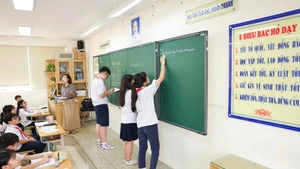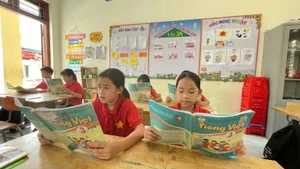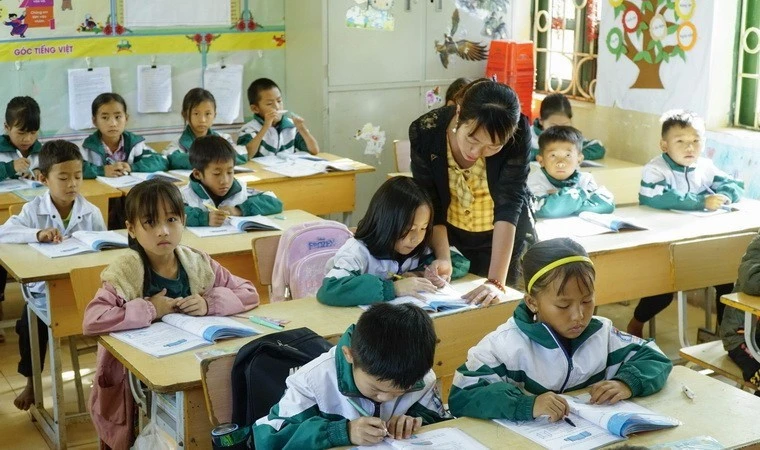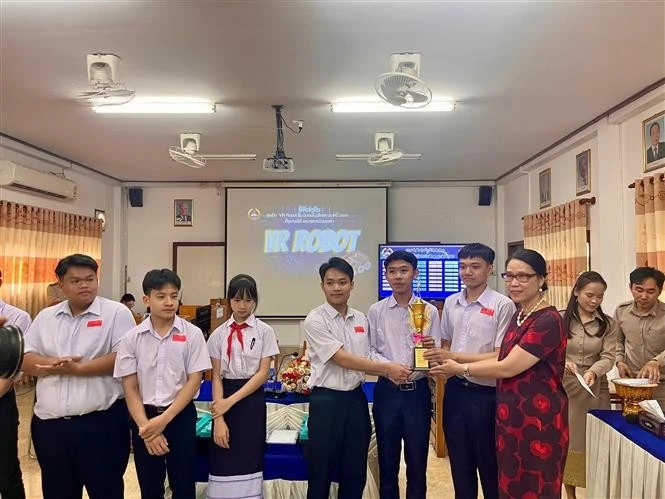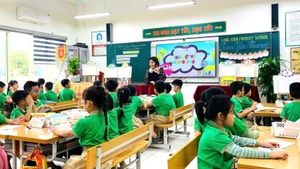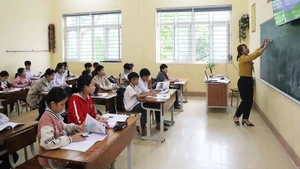United efforts and shared commitment to the cause of education
Ia Dom is a border commune of Gia Lai Province, where living conditions remain difficult, particularly as ethnic minority communities account for a high proportion of the population. However, in recent years, local education has seen many positive developments. The commune now has three main schools: Hoa Polang Kindergarten, Tran Phu Primary School and Nguyen Trai Lower Secondary School, with a total of 1,982 pupils, including as many as 658 ethnic minority pupils.
The 2024–2025 school year concluded with standout achievements: the student retention rate reached 99.7%; 100% of pupils completed the primary education programme; and 100% of Grade 9 pupils graduated from secondary school. These are impressive figures for a disadvantaged border commune like Ia Dom.

At Hoa Polang Kindergarten — where the very first seeds of knowledge are sown — we witnessed the dedication and love for the profession among the teachers. The school has 12 classes with 338 children, including 148 ethnic minority children, and girls account for more than 50%. Although facilities remain limited, the school maintains an attendance rate of 96%, a retention rate of 100%, and notably, 85.5% of children are assessed as “healthy and well-behaved”.
To achieve these “telling numbers”, the school has made great efforts to mobilise all children of school age to attend class, especially those from ethnic minority communities. Smooth coordination between the school and mass organisations such as the Women’s Union, the Youth Union, the commune’s Fatherland Front and village authorities has played a crucial role in ensuring children attend class regularly.
At primary level, Tran Phu School has 28 classes with 962 pupils, of whom 336 are ethnic minority children. In the past school year, the school maintained a retention rate of 99.4%, while 100% of Grade 5 pupils completed the primary education programme. This is a remarkable achievement given that many border-area families still struggle economically and education is not always the top priority.
Not only has the school maintained strong retention rates, but learning outcomes have also improved significantly. Pupils from Tran Phu Primary School have earned many notable achievements in competitions, such as First and Third prizes in the district-level Young Informatics Contest and a provincial-level Consolation prize. In the Vietnamese Traditional Scholar Contest, pupils won 2 Second prizes, 3 Third prizes and 5 Consolation prizes at district level, along with 3 provincial-level Consolation prizes. The teaching staff have also excelled, with three teachers recognised as district-level Excellent Teachers.
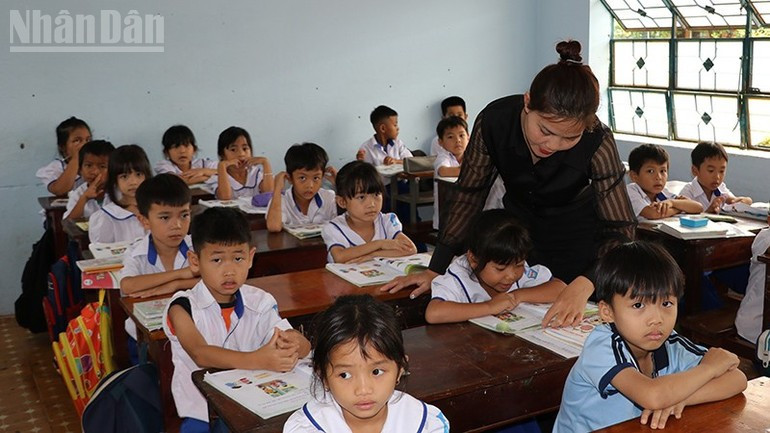
Ro Lan Luc, a Grade 4 pupil at Tran Phu Primary School, shared: “My parents are working in the fields all day, but they always tell me to study hard so I can help them and our village in the future. At school, my teachers guide and support me warmly. I will try to study even better so as not to disappoint my teachers and parents.”
Meanwhile, at Nguyen Trai Lower Secondary School, which has 662 pupils including 174 ethnic minority pupils, the highlight is not only the 100% Grade 9 graduation rate but also strong performance in district- and provincial-level academic contests. Notably, one pupil won a provincial Second prize in Literature and another received a Consolation prize in Geography. The school also boasts six teachers recognised as district-level Excellent Homeroom Teachers.
Joining hands to “help children reach school”
Alongside the proactive efforts of the education sector and local authorities, Ia Dom Commune has also benefited greatly from community support, especially from the armed forces. A notable model worthy of replication is the “Officers and Soldiers Supporting Children to School” Programme implemented directly by Division 320.
In the 2024–2025 school year, Division 320 sponsored 23 disadvantaged students, most of whom were ethnic minority pupils from the three schools in Ia Dom, with total financial assistance reaching nearly 550 million VND. Specifically: Tran Phu Primary School received support for 8 students (191.2 million VND); Nguyen Trai Secondary School with 10 students (239 million VND); and 5 sponsored pupils at Nguyen Truong To School (119.5 million VND).
This assistance is not only of material value but also an invaluable source of encouragement, motivating students to strive harder in both learning and life. Siu H’Ron, father of Siu Nguyen Anh Ky — a grade 5 pupil at Tran Phu Primary School who is sponsored under the programme — shared emotionally: “My family is classified as poor, so we always worry about not being able to afford our child’s long-term schooling. Thanks to the soldiers’ support, we feel comforted and more hopeful about our child’s future.”
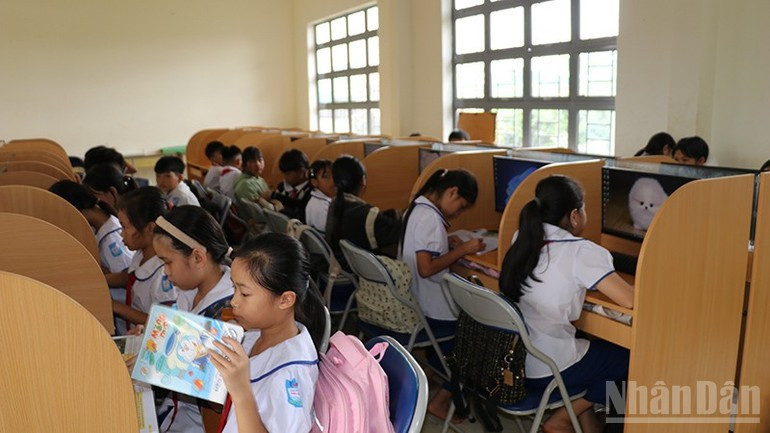
Beyond the armed forces, local enterprises have also actively partnered with the education sector. At the opening ceremony for the 2025–2026 school year, organisations and businesses donated a total of 262 gifts to students at all three schools. Nguyen Trai Secondary School and Tran Phu Primary School alone were given 200 schoolbags and 1,000 notebooks worth 30 million VND.
These modest but meaningful gifts have become a powerful source of encouragement, helping students stay committed to their education and bringing warmth and motivation to each new school year.
At present, Ia Dom Commune continues to strengthen communication and encourage families to send their children to school, especially ethnic minority pupils and those from poor or near-poor households. Strong commitment from Party committees, local authorities, the education sector and the community is creating a valuable “bond of support” that is helping to spread the culture of learning across the border region.
In the context of persistent economic hardship, Ia Dom’s educational achievements are vivid proof of the effectiveness of comprehensive education policies and, in particular, the close coordination between the State, schools and society. The tireless efforts of teachers and pupils, along with the care and support of various social groups, have helped illuminate the “flame of knowledge” along the nation’s border.
Ia Dom is demonstrating that even in a remote border area, the desire for learning, progress and a brighter future for the younger generation remains strong. The “cultivation of people” strategy in this frontier land will continue to serve as a solid foundation for sustainable community development.


